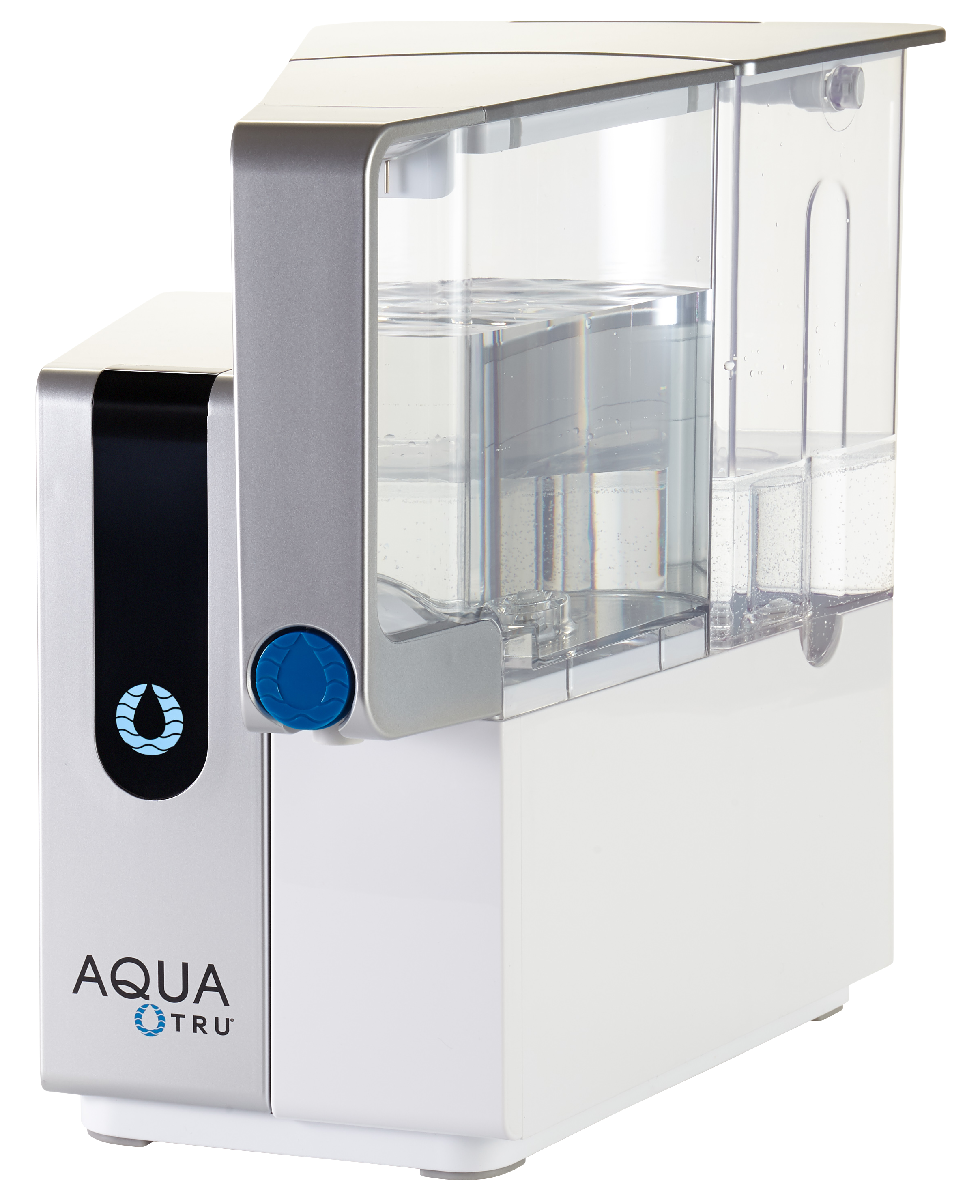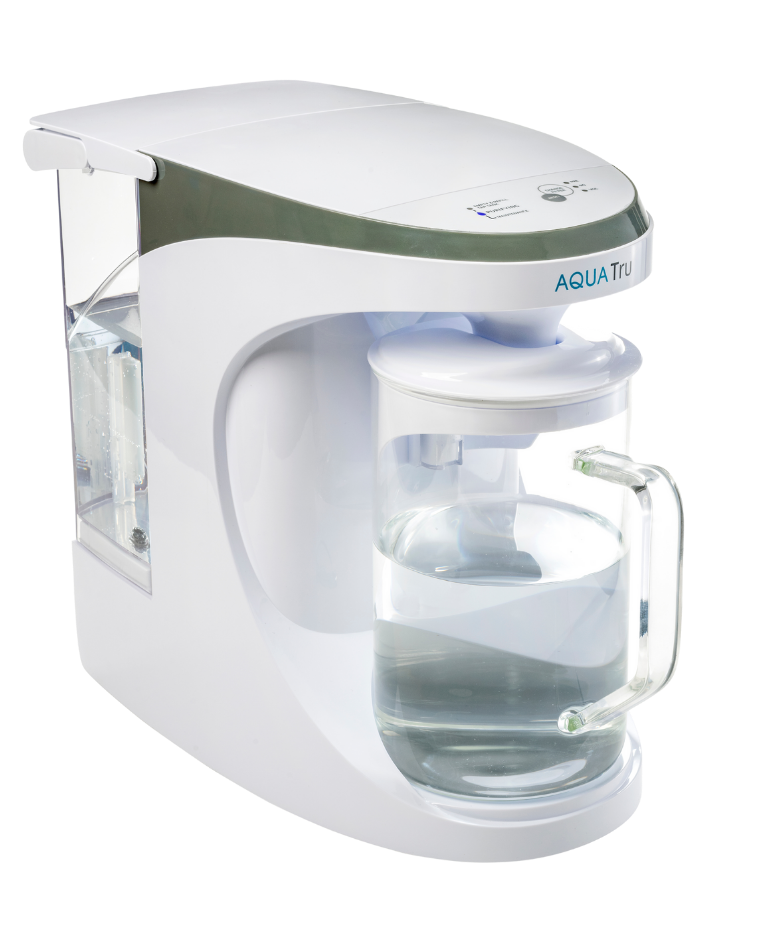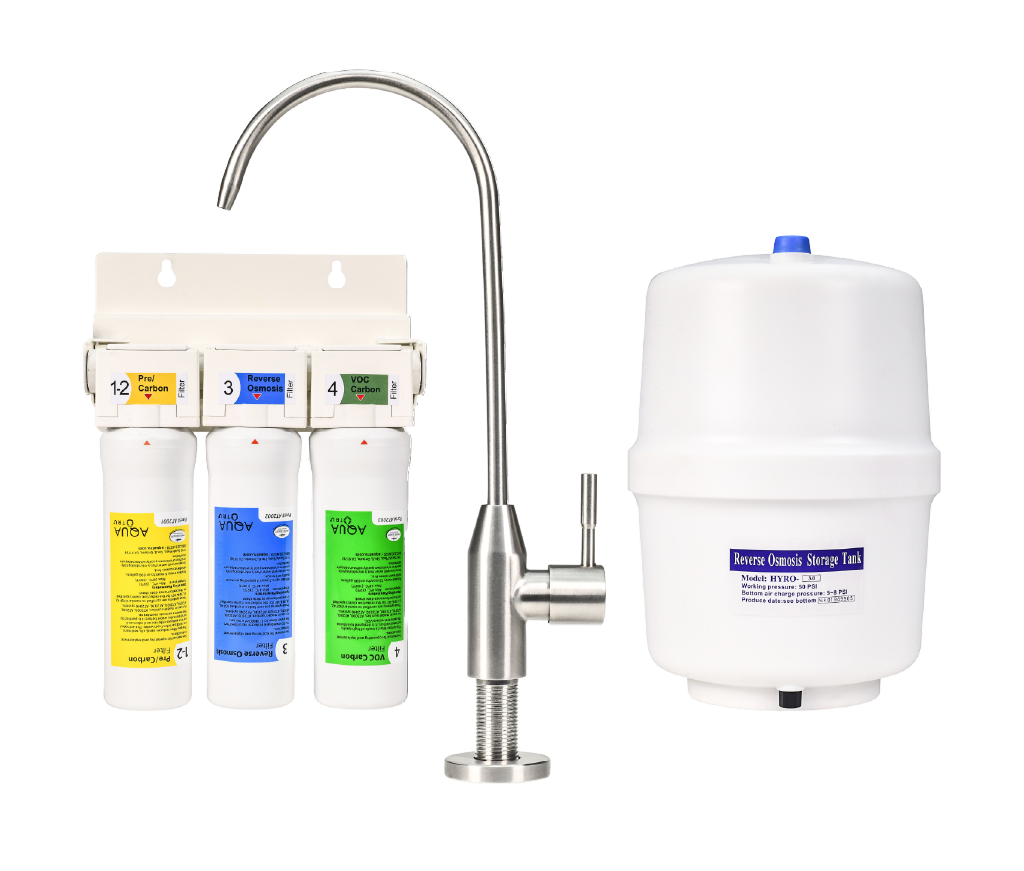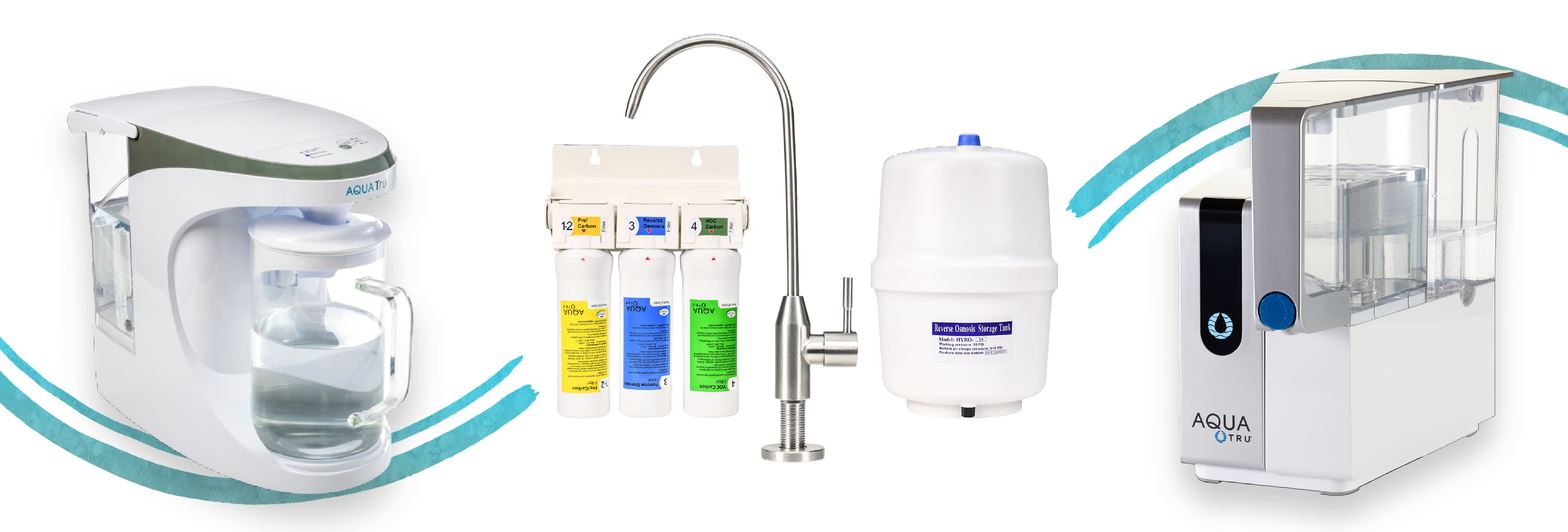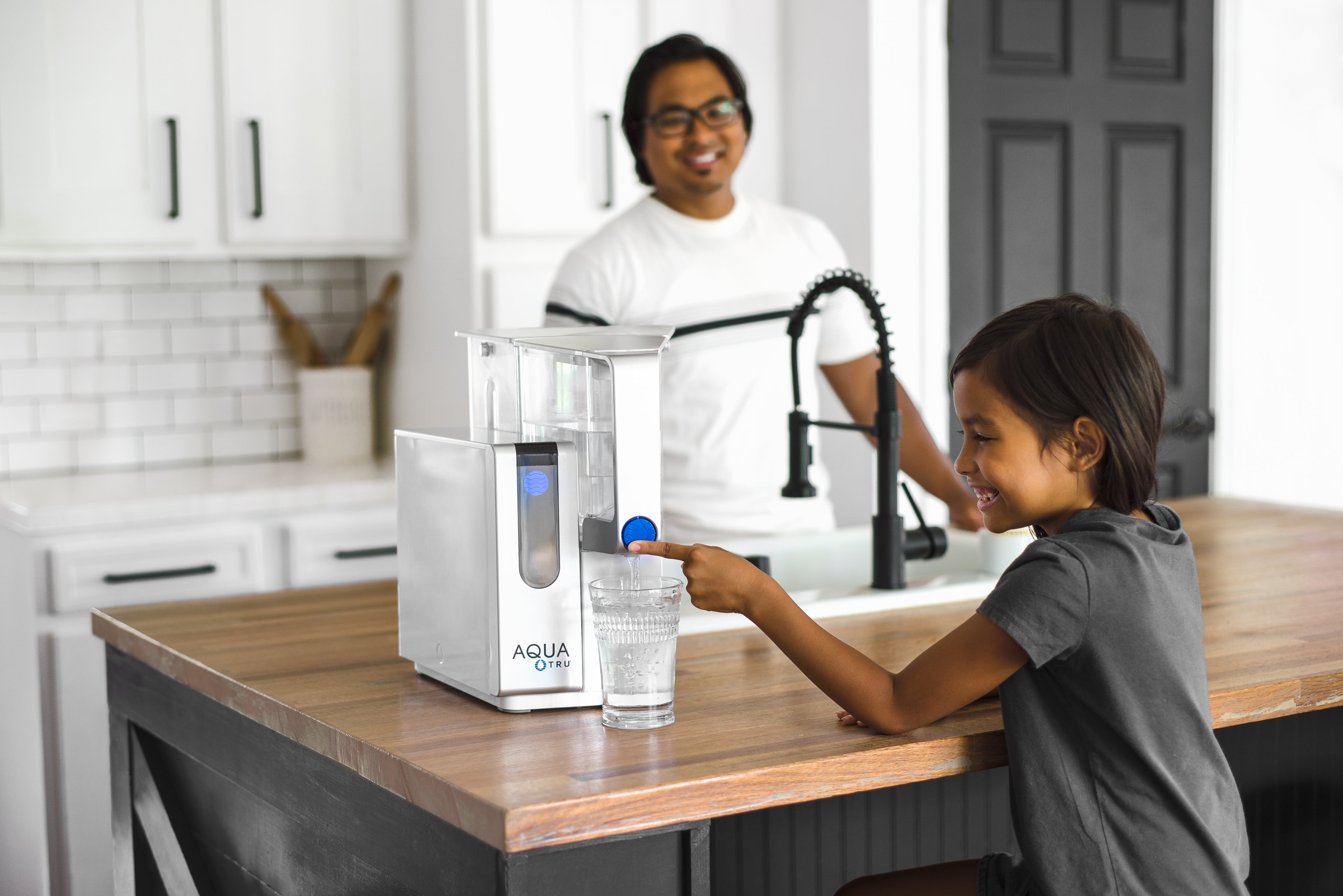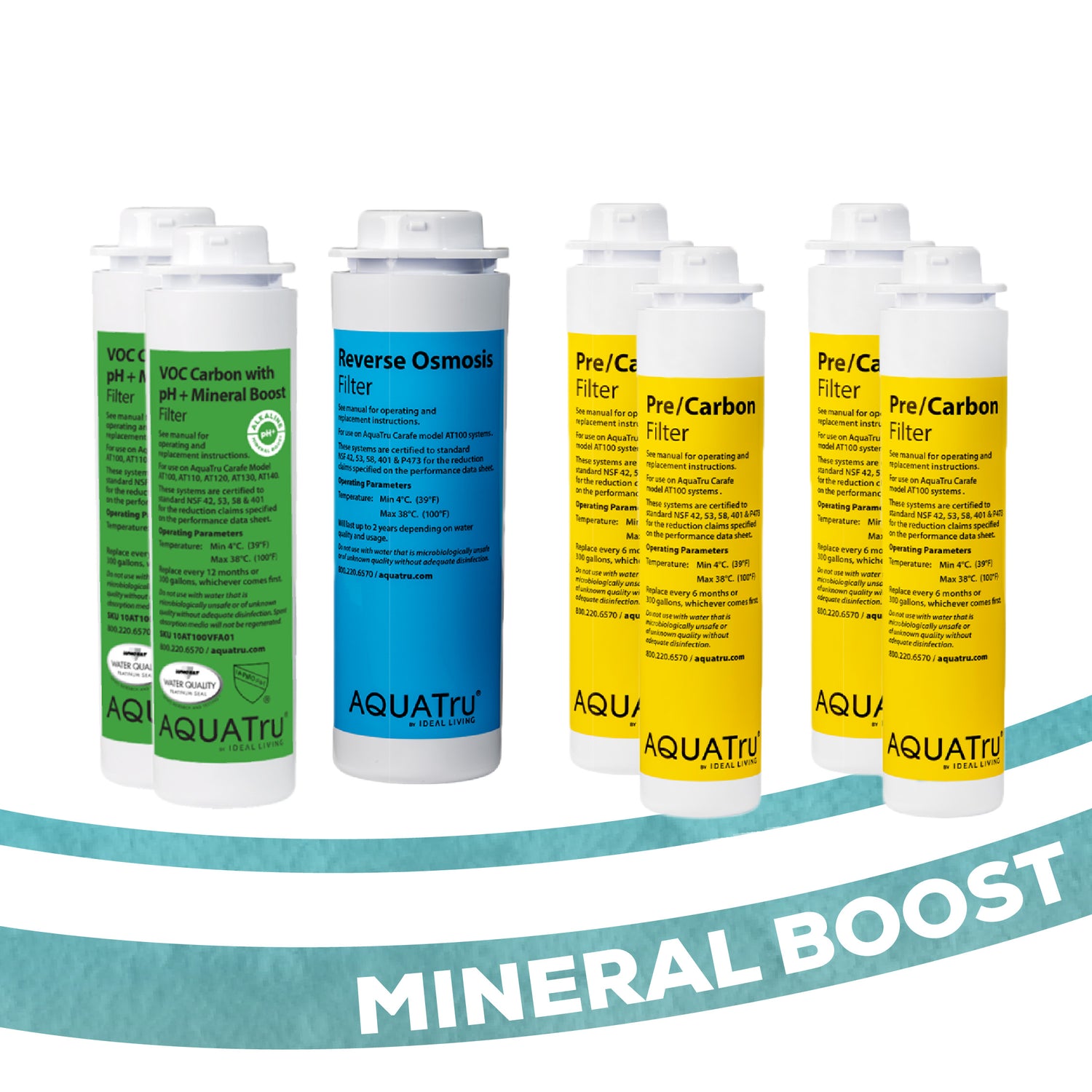Engineered for clean water
At AquaTru, we create advanced water purifiers that remove up to 99% of contaminants—from drug residues and PFAS to fluoride, chlorine, lead, and microplastics—so every glass you drink is cleaner and healthier. Our technology is backed by independent lab testing and performance datasheets certified by IAPMO to meet NSF/ANSI standards. We built this page to help you understand how our purifiers work and why you can trust them.
Designed for simplicity, AquaTru purifiers require no complicated installation. Just fill the tank with tap water, and our 4-stage Reverse Osmosis system takes care of the rest, delivering clean, great-tasting water.
Our Performance Data Sheet offers a clear look at how AquaTru cleans your water. It details TDS levels before and after filtration, lists the contaminants removed, and explains the science behind our process. Independently verified, this data shows exactly how AquaTru keeps your water safe and healthy.
-
Performance Data Sheet
AquaTru Classic
-
Performance Data Sheet
AquaTru Carafe
-
Performance Data Sheet
AquaTru Under SInk
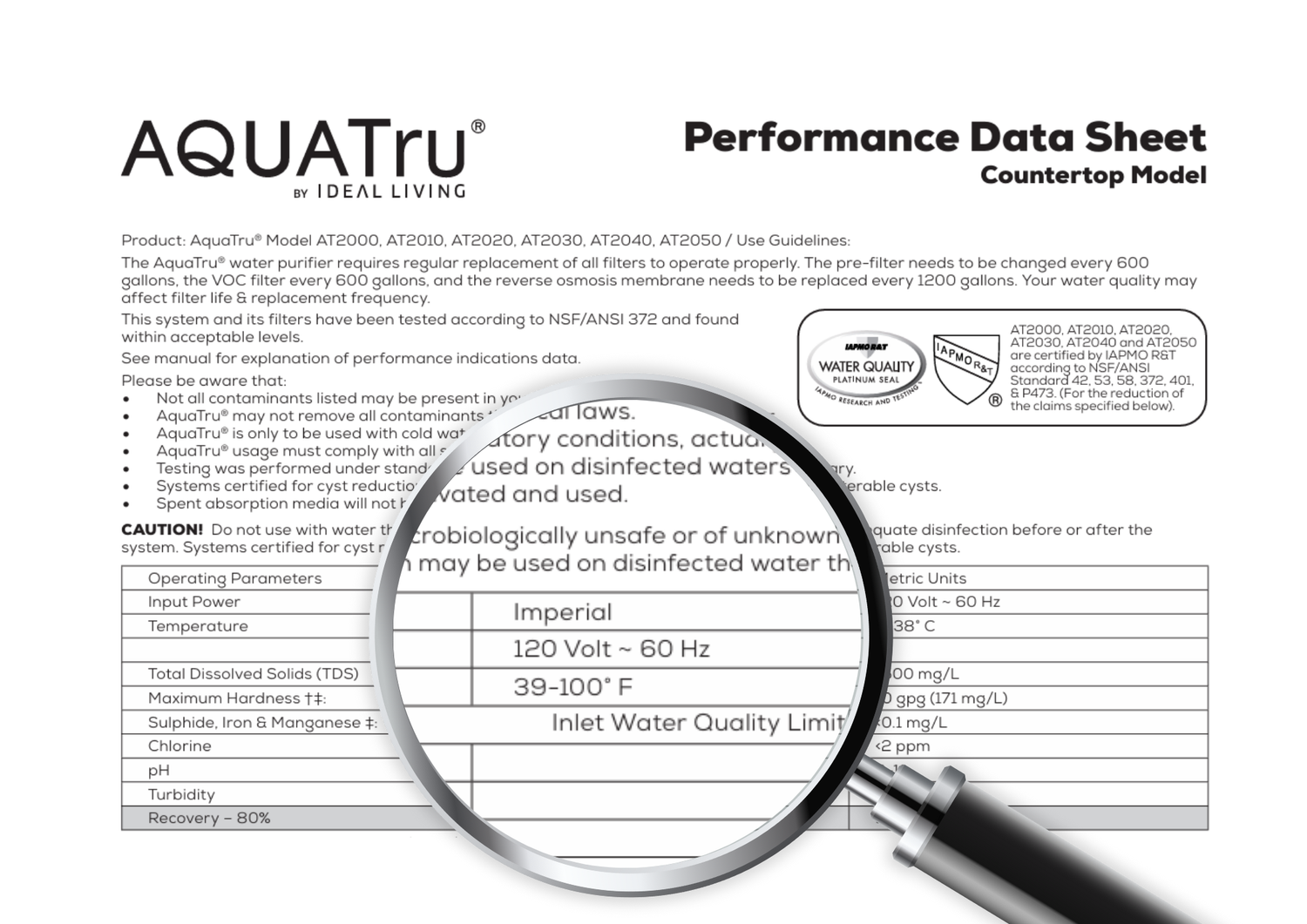
How to read the Performance Data Sheet
Understanding AquaTru’s Performance Data Sheet doesn’t have to feel overwhelming. Let’s break it down step by step to help you make sense of the information and discover how AquaTru works to ensure your water is clean, pure, and safe.
Collapsible content
Step 1: pH levels and TDS – What they mean for your water
- pH Levels: pH measures how acidic or alkaline your water is—a key factor in keeping it balanced and safe to drink. AquaTru supports a wide pH range (3–11), ensuring your water stays in the ideal balance no matter its source.
-
Total Dissolved Solids (TDS): This metric measures all dissolved substances in your water, including minerals, salts, and metals. While some of these, like beneficial minerals and salts, are good for you, unwanted contaminants can also be present. AquaTru reduces TDS by up to 97%, making water clearer and fresher.
- Example: AquaTru reduces TDS from a challenge concentration of 750 mg/L to just 22 mg/L on average.

Step 2: Contaminant categories – What AquaTru removes
To make it easier, contaminants are grouped into categories:
-
Heavy metals: Harmful elements like lead and arsenic are reduced by over 97%, ensuring safety for you and your family
-
Example: Lead is reduced from 0.15 mg/L to as low as 0.01 mg/L.
-
Example: Lead is reduced from 0.15 mg/L to as low as 0.01 mg/L.
- Industrial pollutants: AquaTru eliminates pollutants like benzene and trichloroethylene, often found in industrial areas, with reductions exceeding 99%.
- Pharmaceutical residues: Medications like pain relievers and antibiotics enter water from everyday use and disposal. AquaTru reduces these traces to help keep your water clean and safe.
-
Microplastics and particulates: Removes over 96% of particles as small as 0.5 microns, ensuring your water is free from these invisible pollutants.
- Example: Reduces microplastics from a concentration of 1,400,000 particles/mL to below permissible levels.

Step 3: Reduction metrics – Simplifying the data
Each contaminant’s reduction is expressed in terms of:
- Influent challenge concentration: The level of the contaminant before filtration.
- Maximum permissible concentration: The highest safe level after filtration.
-
Minimum and average reduction: Shows how consistently AquaTru removes contaminants.
- Example: Arsenic is reduced by an average of 98%, significantly lower than the allowable limit of 0.01 mg/L.

This step-by-step guide will help you understand AquaTru’s performance data clearly and confidently. Whether you learn about TDS levels or appreciate how each filter contributes, AquaTru’s transparency inspires trust in every sip.
What AquaTru removes
AquaTru is meticulously engineered to tackle a wide range of impurities in your water. Using advanced filtration technology eliminates harmful substances while preserving the essential balance of clean, safe water.
Grouped contaminants
To make it easier to understand, here’s a quick breakdown of what AquaTru removes, grouped by contaminant type.
Note: Health effects can vary based on dose and duration of exposure; listed effects reflect primary concerns associated with each substance.
Collapsible content
Heavy metals
AquaTru® is designed to reduce dangerous metals that can impact health over time, as long-term exposure to these contaminants has been linked to risks such as organ damage, neurological issues, and even cancer.
Example: Lead levels are reduced by up to 99.1%, going from 0.15 mg/L to below the safe limit of 0.01 mg/L.
| Substance | How it gets into the water | Potential health effects |
|---|---|---|
| Arsenic | Naturally occurring in soil and rocks, industrial waste, pesticides | Skin lesions, cancer, cardiovascular disease, neurological effects |
| Barium | Erosion of natural deposits, industrial discharge, drilling waste | Increased blood pressure, kidney and heart damage |
| Hexavalent Chromium | Often from industrial processes such as electroplating, stainless steel production, or improper disposal of industrial waste | Known carcinogen; can damage the liver, kidneys, and respiratory system |
| Trivalent Chromium | Can be released through certain industrial activities and may also occur naturally in some mineral deposits | An essential nutrient in small amounts, but higher exposures may pose health risks (e.g., skin irritation or other toxicity) |
| Copper | Corrosion of plumbing pipes, industrial waste | Stomach irritation, liver and kidney damage, anemia |
| Lead | Corrosion of old lead pipes, industrial pollution |
Brain damage, developmental issues in children, kidney damage |
| Selenium | Natural deposits, mining, petroleum refining | Hair and nail loss, neurological damage, gastrointestinal issues |
| Radium | Natural radioactive decay of uranium and thorium in soil |
Increased cancer risk, bone weakness, immune system damage |
Industrial pollutants
Industrial Pollutants encompass a broad range of organic chemicals—including pesticides, solvents, and other industrial chemicals—that may be present in water. They are primarily listed under NSF/ANSI 53, with additional chemicals from NSF/ANSI 58, 401 (non‐pharmaceuticals), and P473, and exposure to these substances has been linked to health risks such as endocrine disruption, organ toxicity, and an increased risk of cancer.
Example: Benzene is reduced by over 99%, ensuring safe drinking water.
Below is a succinct, example-style table for each substance. "How it gets into the water" focuses on typical industrial or agricultural pathways, while "Potential health effects" highlights human health concerns.
From NSF/ANSI 53
| Substance | How it gets into the water | Potential health effects |
|---|---|---|
| Alachlor | Herbicide runoff from agricultural fields | Possible cancer risk, liver/kidney damage |
| Atrazine | Herbicide runoff from crop application | Endocrine disruption, reproductive issues |
| Benzene | Industrial discharge, leaking fuel storage tanks, spills | Carcinogenic, blood and bone marrow disorders |
| Carbofuran | Pesticide runoff from insecticide use | Neurological effects, possible reproductive harm |
| Carbon Tetrachloride | Industrial solvent use, improper disposal | Liver, kidney, and CNS damage |
| Chlorbenzene | Chemical manufacturing and industrial discharge | Liver/kidney damage with prolonged exposure |
| Chlorpicrin | Pesticide/fumigant use, runoff | Respiratory irritation, eye/skin irritation |
| 2,4-D (2,4-dichlorophenoxyacetic acid) | Herbicide runoff from agricultural and lawn care | Possible endocrine disruption, liver/kidney effects |
| Dibromochloropropane (DBCP) | Soil fumigant, leaching from treated fields | Reproductive damage, possible carcinogen |
| o-Dichlorobenzene | Industrial discharge, solvent usage | Liver/kidney damage, respiratory irritation |
| p-Dichlorobenzene | Mothball/deodorizer usage, industrial discharge | Liver damage, possible carcinogenicity |
| 1,2-Dichloroethane | PVC production, industrial discharge | Carcinogenic, nervous system and liver damage |
| 1,1-Dichloroethylene | Plastic manufacturing, industrial releases | Liver toxicity, CNS effects |
| Cis-1,2-Dichloroethylene | Breakdown of chlorinated solvents, industrial spills | Liver toxicity, neurological effects |
| Trans-1,2-Dichloroethylene | Breakdown of chlorinated solvents, industrial spills | Liver toxicity, neurological effects |
| 1,2-Dichloropropane | Chemical manufacturing, fumigant use | Possible carcinogen, respiratory irritation |
| Cis-1,3-Dichloropropylene | Pesticide use, industrial runoff | Respiratory/skin irritation, possible liver effects |
| Dinoseb | Herbicide runoff from treated fields | Reproductive toxicity, skin/eye irritation |
| Endrin | Insecticide runoff, persistence in soil | Neurotoxic, possible liver damage |
| Ethylbenzene | Petroleum refining, industrial discharge, spills | Respiratory irritation, potential liver/kidney damage |
| Ethylene Dibromide (EDB) | Leaded gasoline additive, fumigant usage | Carcinogenic, reproductive toxicity |
|
Haloacetonitriles (Bromochloroacetonitrile, Dibromoacetonitrile, Dichloroacetonitrile, Trichloracetonitrile) |
Byproducts of chlorinated water disinfection | Possible carcinogenicity, irritation to eyes/skin |
| Haloketones(1,1-Dichloro-2-propane, 1,1,1-Trichloro-2-propane) | Byproducts of chlorination in water treatment | Possible mutagenic effects, mucous membrane irritation |
| Heptachlor | Termiticide use, runoff from contaminated soil | Possible carcinogen, neurotoxic, liver damage |
| Heptachlor Epoxide | Breakdown product of heptachlor in the environment | Potential carcinogen, neurotoxicity |
| Hexachlorobutadiene | Chemical manufacturing, industrial waste | Kidney damage, possible carcinogenicity |
| Hexachlorocyclopentadiene | Pesticide manufacturing, industrial discharge | Eye/skin irritation, liver/kidney toxicity |
| Lindane | Insecticide runoff, improper disposal | Neurotoxic, possible endocrine disruption |
| Methoxychlor | Insecticide runoff from agricultural use | Endocrine disruption, reproductive toxicity |
| Pentachlorophenol | Wood preservative use, industrial discharge | Liver/kidney damage, possible carcinogen |
| Simazine | Herbicide runoff from agricultural fields | Possible endocrine disruption, organ toxicity |
| Styrene | Plastic/resin manufacturing, industrial discharge | Nervous system effects, possible carcinogenicity |
| 1,1,2,2-Tetrachloroethane | Chemical manufacturing, solvent use | Liver/kidney damage, possible carcinogen |
| Tetrachloroethylene | Dry cleaning solvent, industrial discharge | Possible carcinogen, neurological/liver effects |
| Toluene | Petroleum products, industrial discharge, spills | Neurological effects, possible reproductive harm |
| 2,4,5-TP (Silvex) | Herbicide runoff, defoliant use | Liver/kidney damage, possible reproductive toxicity |
| Tribromoacetic Acid | Byproduct of water disinfection (chlorination) | Possible carcinogenicity, skin/eye irritant |
| 1,2,4-Trichlorobenzene | Solvent use, industrial discharge | Liver/kidney damage, skin/eye irritation |
| 1,1,1-Trichloroethane | Industrial solvent, degreasing operations | CNS depression, liver damage |
| 1,1,2-Trichloroethane | Chemical intermediate, industrial spills | Liver/kidney toxicity, possible carcinogen |
| Trichloroethylene | Metal degreasing, industrial discharge | Carcinogenic, liver/kidney damage, neurotoxicity |
|
Trihalomethanes (Chloroform, Bromoform, Bromodichloromethane, Chlorodibromomethane) |
Byproducts of chlorination in drinking water | Possible carcinogenicity, liver/kidney issues |
| Xylenes | Petroleum refining, industrial spills, solvent usage | Neurological effects, possible liver/kidney damage |
From NSF/ANSI 58
| Substance | How it gets into the water | Potential health effects |
|---|---|---|
| Fluoride | Discharged from industrial processes (e.g., aluminum smelting, phosphate fertilizer production) and natural sources | Dental and skeletal fluorosis; potential neurotoxicity at high exposures |
| Perchlorate | Released from manufacturing of rocket fuel, explosives, and related industrial processes | Disrupts thyroid function, leading to hormonal imbalances and metabolic effects |
| Nitrate (as N) and Nitrite (as N) |
Primarily through fertilizer runoff, animal manure, septic systems, and sewage | High nitrate/nitrite in drinking water can lead to methemoglobinemia (“blue baby syndrome”) in infants and may pose reproductive or developmental risks in adults |
From NSF/ANSI 42
| Substance | How it gets into the water | Potential health effects |
|---|---|---|
| Chlorine | Added by municipalities as a disinfectant to kill microbes | Can form disinfection byproducts linked to an elevated cancer risk with long‐term exposure; also imparts a strong taste/odor |
| Perchlorate | Used by some water utilities alongside or instead of chlorine to maintain a longer‐lasting disinfectant residual | May irritate skin/eyes in sensitive individuals; can corrode older plumbing, potentially releasing lead or copper into tap water |
From the non‐pharmaceutical part of NSF/ANSI 401
| Substance | How it gets into the water | Potential health effects |
|---|---|---|
| TCEP | Industrial discharge and leaching from flame-retardant treated products | Carcinogenic, endocrine disruption, reproductive/developmental effects |
| TCPP | Industrial discharge and leaching from treated materials | Endocrine disruption, developmental toxicity, potential carcinogen |
| DEET | Domestic wastewater from personal use and manufacturing discharge | Skin/eye irritation, neurological effects at high exposures |
| Metolachlor | Agricultural runoff from herbicide use and manufacturing discharge | Potential carcinogen, liver toxicity, endocrine disruption |
| Bisphenol A | Leaching from plastics and industrial wastewater | Endocrine disruption, reproductive effects |
| Linuron | Agricultural runoff from herbicide application and manufacturing discharge | Endocrine disruption, potential carcinogenicity |
| Nonyl phenol | Industrial discharge and wastewater effluent from surfactant production | Endocrine disruption, reproductive toxicity |
From NSF/ANSI P473
| Substance | How it gets into the water | Potential health effects |
|---|---|---|
| Perfluorooctanoic acid (PFOA) | Industrial discharge from manufacturing non-stick coatings, water repellents, and related products | Developmental effects, liver damage, endocrine disruption, potential carcinogenicity |
| Perfluorooctane sulfonate (PFOS) | Released from industrial processes and firefighting foams, as well as consumer products like stain repellents | Thyroid disruption, immune system effects, developmental toxicity, potential carcinogenicity |
These chemicals—whether they originate from industrial waste, pesticide use, or persistent organic pollutants—fall under the umbrella of industrial contaminants.
Pharmaceutical residues
Under NSF/ANSI 401, AquaTru® has been tested for removing modern drug contaminants, as chronic exposure to pharmaceutical residues in water may disrupt endocrine function and contribute to other adverse health effects.
Example: Ibuprofen levels are reduced by 95.1%, giving you peace of mind about what’s in your water.
| Substance | How it gets into the water | Potential health effects |
|---|---|---|
| Meprobamate | Excreted by patients; improper disposal of unused medication | Sedation, central nervous system effects |
| Phenytoin | Excreted by patients; disposal of leftovers | Neurological impacts |
| Atenolol | Excreted by patients; disposal of unused pills | Blood pressure and heart rate changes |
| Carbamazepine | Excreted by patients; resistant to conventional treatment | Neurological and possible endocrine effects |
| Trimethoprim | Excreted by patients; improper disposal | Allergic reactions; contributes to antibiotic resistance |
| Ibuprofen | Commonly used; excreted after use; improper disposal | Gastrointestinal and kidney concerns |
| Naproxen | Over-the-counter use; excreted; improper disposal | Gastrointestinal irritation, cardiovascular risks |
| Estrone | Natural hormone excretion; hormone therapies | Endocrine disruption, reproductive issues |
Note: Health effects can vary based on dose and duration of exposure; listed effects reflect primary concerns associated with each substance.
Microplastics and particulates
AquaTru® reduces extremely small particles by 96.48%—including microplastics, which may cause inflammation and carry harmful chemicals, and cysts that can lead to gastrointestinal illness. By targeting these tiny but harmful contaminants, AquaTru ensures cleaner, safer water.
Example: From an initial concentration of 1,400,000 particles/mL, AquaTru effectively filters out the vast majority, leaving your water significantly cleaner.
| Substance | How it gets into the water | Potential health effects |
|---|---|---|
| Microplastics, Particles 0.5 to < 1 µm | Breakdown of larger plastic debris, synthetic fibers, industrial runoff | Inflammation, carriers for chemicals that disrupt cellular functions |
| Cyst | Typically from fecal contamination or infiltration of surface water containing protozoa (e.g., Giardia, Cryptosporidium) | Gastrointestinal illness, including diarrhea, vomiting, and potential longer‐term health issues if untreated |
Note: Particulate Class I (NSF/ANSI 42 substance) refers to very fine suspended particles sized 0.5 to less than 1.0 microns in diameter. This category includes microplastics as well as other microscopic solids.
Why it matters
The contaminants listed above are not just numbers—they represent real threats to water quality. AquaTru’s filtration system ensures that your water is not only free from harmful substances but also tastes fresh and pure.
With AquaTru, every glass is a step towards cleaner, healthier hydration for you and your family.
Key highlights of AquaTru's performance
AquaTru is designed to redefine your experience with water purification. Its advanced filtration system ensures cleaner, healthier water that you can trust. Here are the key highlights of its performance, presented in a way that's easy to understand and grounded in science.
Why these results stand out
AquaTru's performance is validated across multiple models (Classic, Carafe, and Under Sink) under stringent laboratory conditions. While specific results may vary by model, each is engineered to meet the highest standards of water purification, ensuring that what you drink is as pure as possible.
These highlights are more than just statistics—they reflect AquaTru's commitment to delivering better water, one sip at a time.
Customer questions answered
What is TDS, and why does it matter?
TDS (Total Dissolved Solids) measures the combined concentration of dissolved substances in water, such as minerals, salts, and metals. While some TDS levels occur naturally and are safe, excessive TDS can affect water’s taste, odour, and safety. AquaTru effectively reduces TDS by up to 97%, ensuring your water is not only safe but also tastes great.
Are microplastics really that common in tap water?
Unfortunately, yes. Microplastics—tiny plastic particles less than 5 millimetres in size—have been detected in water supplies worldwide. AquaTru removes over 96% of microplastic particles as small as 0.5 microns, providing an extra layer of protection for your health.
How does AquaTru impact pH levels?
AquaTru is compatible with water sources with a pH range of 3 to 11. While the reverse osmosis process may slightly lower the pH, this is natural for purified water. For those who prefer alkalised water, AquaTru offers an optional VOC Carbon with pH+ Mineral Boost filter, which can balance pH levels and enhance the taste.
How often do I replace the filters?
Filter replacement is essential to maintaining AquaTru’s performance. Each filter is designed with a specific function and lifespan, and replacement timelines vary slightly depending on the model:
For the Classic and Under Sink models:
- Pre/Carbon Filter (1-2): Replace every six months or 2270 litres, whichever comes first.
- Reverse Osmosis Filter (3): Replace every two years or 4540 litres, whichever comes first.
- Carbon VOC Filter (4): Replace every year or 2270 litres, whichever comes first.
For the Carafe model:
While the Carafe filters water at a smaller scale, the lifespan is similar, but it filters fewer litres:
- Pre/Carbon Filter (1-2): Replace every six months or 1135 litres, whichever comes first.
- Reverse Osmosis Filter (3): Replace every two years or 2270 litres, whichever comes first.
Carbon VOC Filter (4): Replace every year or 1135 litres, whichever comes first.
Ready for pure water you can trust?
Take the first step towards healthier, cleaner water for you and your family. With AquaTru’s advanced filtration technology, you can enjoy peace of mind knowing every drop is pure, safe, and delicious.

